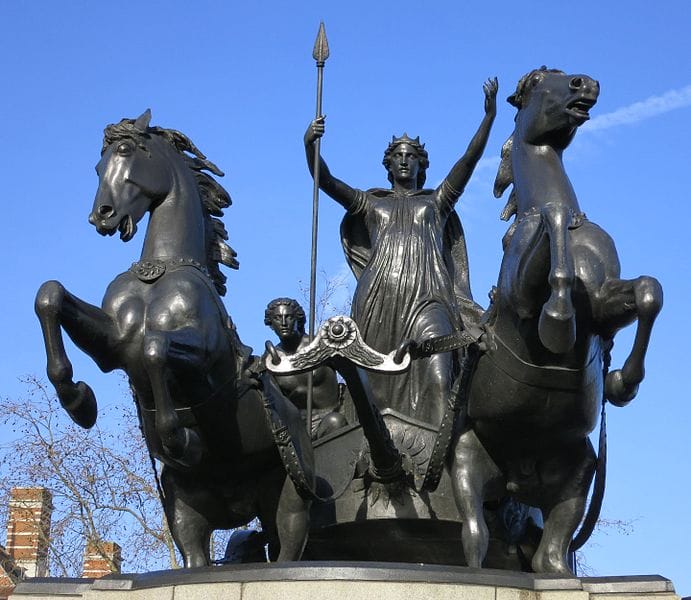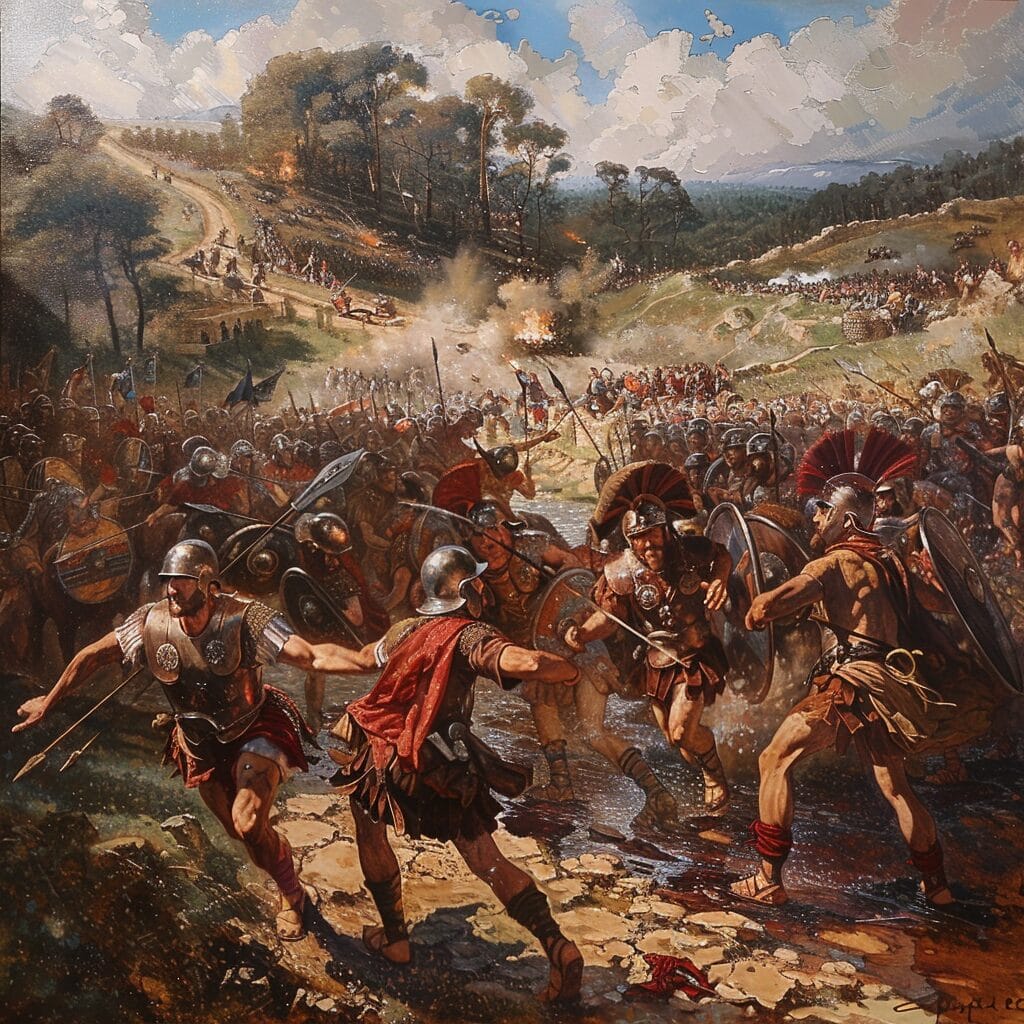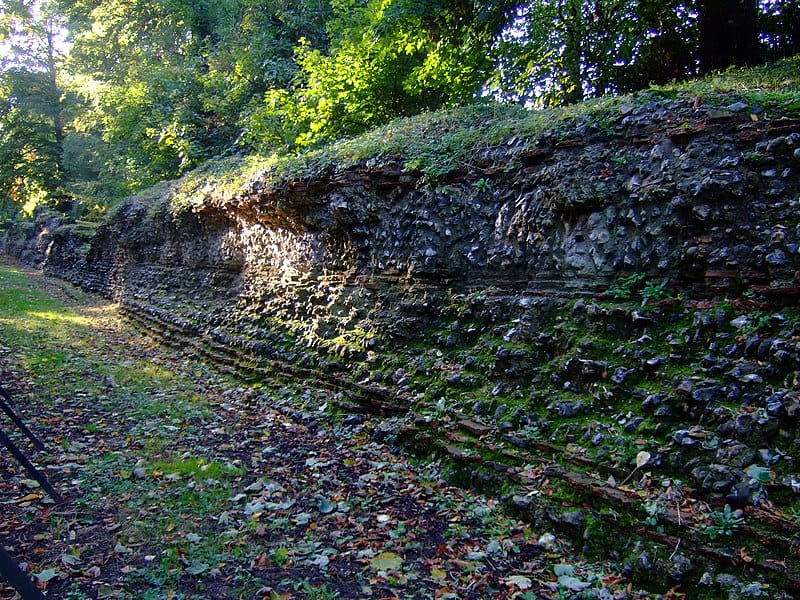The Battle of Watling Street was a significant event in the history of Roman Britain, fought in AD 61 between the forces of the Roman Empire led by Governor Gaius Suetonius Paulinus and the Britons led by Queen Boudica. The battle took place near modern-day Birmingham, England, and resulted in a decisive victory for the Romans.
The battle took place during a period of unrest in Roman Britain, as the native tribes rebelled against Roman rule and sought to regain their independence. Boudica’s rebellion was one of the most serious challenges to Roman authority in the province, and her army had already sacked several Roman towns and killed thousands of civilians before the two sides met in battle.
The Roman army, heavily outnumbered by the Britons, deployed in a narrow defile between two forests, which prevented Boudica’s forces from using their superior numbers to surround them. The Romans used their superior discipline and training to hold their ground against the Britons’ fierce charges and eventually broke their lines, causing heavy casualties and routing the survivors. Boudica herself is believed to have died shortly after the battle, either by suicide or illness.

Source: Paul Walter, CC BY 2.0 https://creativecommons.org/licenses/by/2.0, via Wikimedia Commons
Key Takeaways
- The Battle of Watling Street was a decisive victory for the Roman Empire over the native Britons.
- The battle took place during a period of unrest in Roman Britain as the native tribes sought to regain their independence.
- The Romans’ superior discipline and training allowed them to overcome the Britons’ numerical advantage and win the battle.
Historical Context
Roman Conquest of Britain
The Roman conquest of Britain began in AD 43 when Emperor Claudius sent four legions to invade the island. Over the next few decades, the Romans established control over most of southern Britain, building roads, fortresses, and towns. The native Britons were gradually assimilated into Roman culture, adopting Latin as their language and worshipping Roman gods.
Boudica’s Revolt
In AD 60 or 61, the Iceni tribe, led by Queen Boudica, rebelled against Roman rule. The Romans had confiscated the Iceni’s lands and enslaved their people, and Boudica sought revenge. She led an army of tens of thousands of Britons in an attack on the Roman city of Camulodunum (modern-day Colchester). The Romans were caught off guard and suffered a humiliating defeat.
Battle of Watling Street
The exact location of the battle is unknown, but it is believed to have taken place somewhere in the Midlands region of England, along the Roman road known as Watling Street. The battle was a decisive victory for the Romans, who used superior tactics and discipline to defeat the larger but less organized Briton army. Boudica’s forces suffered heavy losses, and she herself is believed to have died shortly after the battle.
The Roman conquest of Britain was a significant event in world history, marking the beginning of Roman rule on the island that would last for almost four centuries. Boudica’s revolt and the Battle of Watling Street, in particular, are important reminders of the resilience and bravery of the native Britons in the face of Roman domination.

The Battle
Combatants
The Roman army consisted of around 10,000 well-trained and heavily armed soldiers, while the British forces were estimated to be around 100,000 warriors.
Tactics and Formation
The Roman army was divided into three parts: the infantry in the center, the cavalry in the wings, and the auxiliaries at the rear. They formed a wedge-shaped formation to break through the enemy lines. On the other hand, the British forces were disorganized and lacked discipline. They formed a long line of warriors, which made them vulnerable to the Roman cavalry.
Course of the Battle
The Battle of Watling Street began with a fierce charge by the British forces, who hoped to overwhelm the Romans with their sheer numbers. However, the Roman infantry held their ground and formed a shield wall, which protected them from the enemy’s attacks. The Roman cavalry then attacked the British flanks, causing chaos and confusion among their ranks.
Despite their initial success, the British forces were eventually defeated due to their lack of discipline and organization. Queen Boudica was forced to flee the battlefield, and many of her warriors were killed or captured by the Romans.
Aftermath and Impact
Casualties and Losses
The exact number of casualties on both sides is unknown, but it is believed that the Romans suffered fewer losses than the Britons. According to Tacitus, around 80,000 Britons were killed, while the Romans lost only 900 men.
The defeat of the Britons had a significant impact on the future of Roman Britain. It ended the threat of rebellion and allowed the Romans to consolidate their power in the region. The Britons, on the other hand, were left devastated and vulnerable to further Roman attacks after the battle of Watling Street.
Roman Occupation After the Battle
Following the Battle of Watling Street, the Romans continued their occupation of Britain for several more centuries. They built new towns, roads, and fortifications and established a lasting legacy that can still be seen in the country today.
The victory in the Battle of Watling Street also helped to cement the reputation of Governor Suetonius Paulinus as a skilled military commander and loyal servant of Rome. He was later appointed as the governor of another province and continued to serve the empire with distinction.
Archaeological Findings
Archaeological findings related to the Battle of Watling Street have shed light on the events that took place during the battle. Excavations have revealed a significant amount of information about the weapons, tactics, and strategies used by both the Roman and British forces.
One of the most significant findings was the discovery of a large number of Roman military artifacts, including swords, spears, and armor. These findings suggest that the Roman army was well-equipped and well-prepared for the battle. The discovery of a large number of British weapons, including chariot parts and sling bullets, indicates that the British forces also put up a strong defense.
Excavations have also revealed evidence of the battle itself. The remains of soldiers and horses have been found, along with evidence of a large-scale battle. The discovery of a mass grave containing the remains of over 1,000 soldiers has been linked to the Battle of Watling Street.
In addition, archaeologists have found evidence of the impact the battle had on the local population. The discovery of burned buildings and destroyed crops suggests that the battle was not confined to the battlefield but also affected the surrounding area.
The archaeological findings related to the Battle of Watling Street provide valuable insights into the events that took place during the battle. They help us to better understand the tactics and strategies used by both sides, as well as the impact the battle had on the local population.
Legacy and Cultural Significance
Boudica’s Place in History
The Battle of Watling Street marked the end of Boudica’s rebellion against Roman rule in Britain. Despite her defeat, Boudica remains an iconic figure in British history, known for her bravery and her fight against oppression. Her story has been retold in many forms, including literature, art, and film, and she is often celebrated as a symbol of resistance.

Source: https://flic.kr/p/apwAfT
Boudica’s legacy has also been the subject of much debate. Some historians see her as a hero, fighting for her people’s freedom against a brutal invader. Others argue that her rebellion was ultimately useless and that her tactics were unnecessarily brutal. Regardless of one’s opinion of her, however, Boudica’s story continues to capture the imagination and inspire people today.
Modern Remembrance
The Battle of Watling Street and Boudica’s rebellion have left a lasting impact on British culture. Many towns and cities in the UK have streets and buildings named after Boudica, and she is often depicted in art and literature. In recent years, there has been a renewed interest in Boudica, with new books and documentaries exploring her story.
The battle site itself has also become a place of pilgrimage for those interested in Boudica’s story. While the exact location of the battle is not known, there are several sites in the area that are associated with the battle. These include the Roman town of Verulamium (now St Albans), which was sacked by Boudica’s army, and the village of Kings Langley, where Boudica is said to have made her last stand.

Source: James Cridland from London, UK, CC BY 2.0 https://creativecommons.org/licenses/by/2.0, via Wikimedia Commons
Overall, the Battle of Watling Street and Boudica’s rebellion continue to be remembered and celebrated as a key moment in British history. While the legacy of Boudica and her rebellion is complex, her story remains an important part of the cultural heritage of the UK.
People Also Ask:
What were the strategic outcomes of the confrontation?
The Battle of Watling Street was a significant event in Roman Britain’s history. The Roman army, led by Governor Gaius Suetonius Paulinus, successfully defeated the rebel forces led by Queen Boudica. The victory ensured Roman control over Britain and prevented the spread of rebellion to other parts of the empire.
How did the tactics of the opposing forces differ?
The Roman army employed a disciplined and organized approach, using their superior weaponry and training to their advantage. They formed a defensive line and relied on their shields to protect themselves from the enemy’s charge. In contrast, the Britons used a more chaotic approach, relying on their numbers and individual bravery to overwhelm the enemy. They charged into battle without any clear strategy, which ultimately led to their defeat.
What was the significance of the battle’s location?
The Battle of Watling Street took place in the East Midlands of England, on a Roman road that connected London to Chester. The location was strategically important for both sides, as it provided easy access to key cities and trade routes. The battle’s outcome ensured that Roman control over Britain remained intact, and the road continued to serve as a vital transportation route.
What were the estimated casualties on both sides?
Estimates of the casualties in the Battle of Watling Street vary widely. While the exact number of casualties is unknown, it is believed that the Britons suffered heavy losses, with some sources suggesting that up to 80,000 were killed. The Roman losses were comparatively low, with estimates ranging from 400 to 1,000 soldiers.
How has the battle influenced subsequent historical events?
The Battle of Watling Street has had a significant impact on British history. It marked the end of Boudica’s rebellion and ensured Roman control over Britain for several more decades. The battle also highlighted the strength of Roman military power and the importance of disciplined tactics in warfare.
Archaeological evidence related to the Battle of Watling Street has been limited. However, excavations have uncovered Roman military equipment and artifacts, such as swords, helmets, and shields, in the area where the battle took place. These findings provide valuable insights into the tactics and weapons used by the Roman army during the battle.
Hello, my name is Vladimir, and I am a part of the Roman-empire writing team.
I am a historian, and history is an integral part of my life.
To be honest, while I was in school, I didn’t like history so how did I end up studying it? Well, for that, I have to thank history-based strategy PC games. Thank you so much, Europa Universalis IV, and thank you, Medieval Total War.
Since games made me fall in love with history, I completed bachelor studies at Filozofski Fakultet Niš, a part of the University of Niš. My bachelor’s thesis was about Julis Caesar. Soon, I completed my master’s studies at the same university.
For years now, I have been working as a teacher in a local elementary school, but my passion for writing isn’t fulfilled, so I decided to pursue that ambition online. There were a few gigs, but most of them were not history-related.
Then I stumbled upon roman-empire.com, and now I am a part of something bigger. No, I am not a part of the ancient Roman Empire but of a creative writing team where I have the freedom to write about whatever I want. Yes, even about Star Wars. Stay tuned for that.
Anyway, I am better at writing about Rome than writing about me. But if you would like to contact me for any reason, you can do it at contact@roman-empire.net. Except for negative reviews, of course. 😀
Kind regards,
Vladimir
